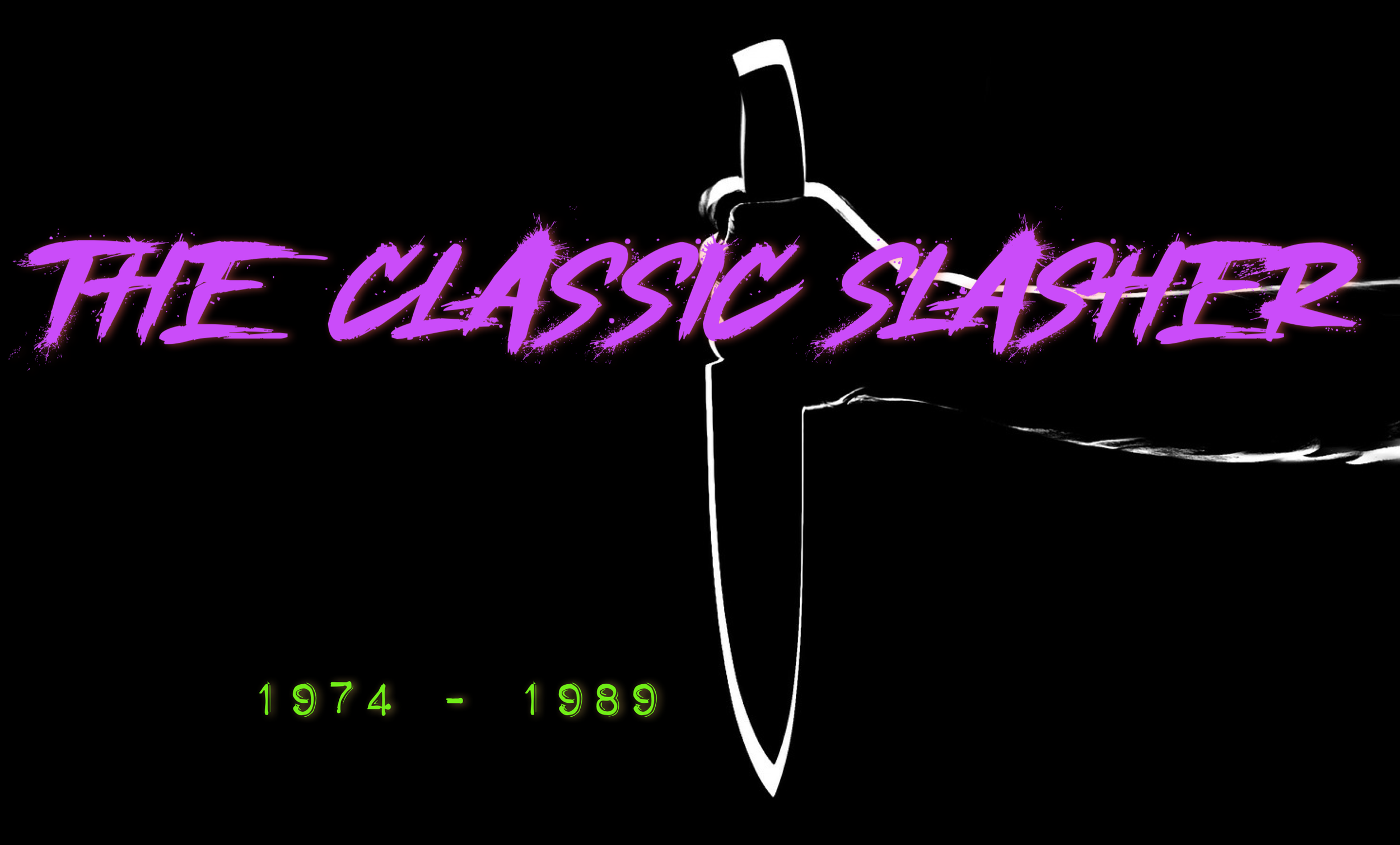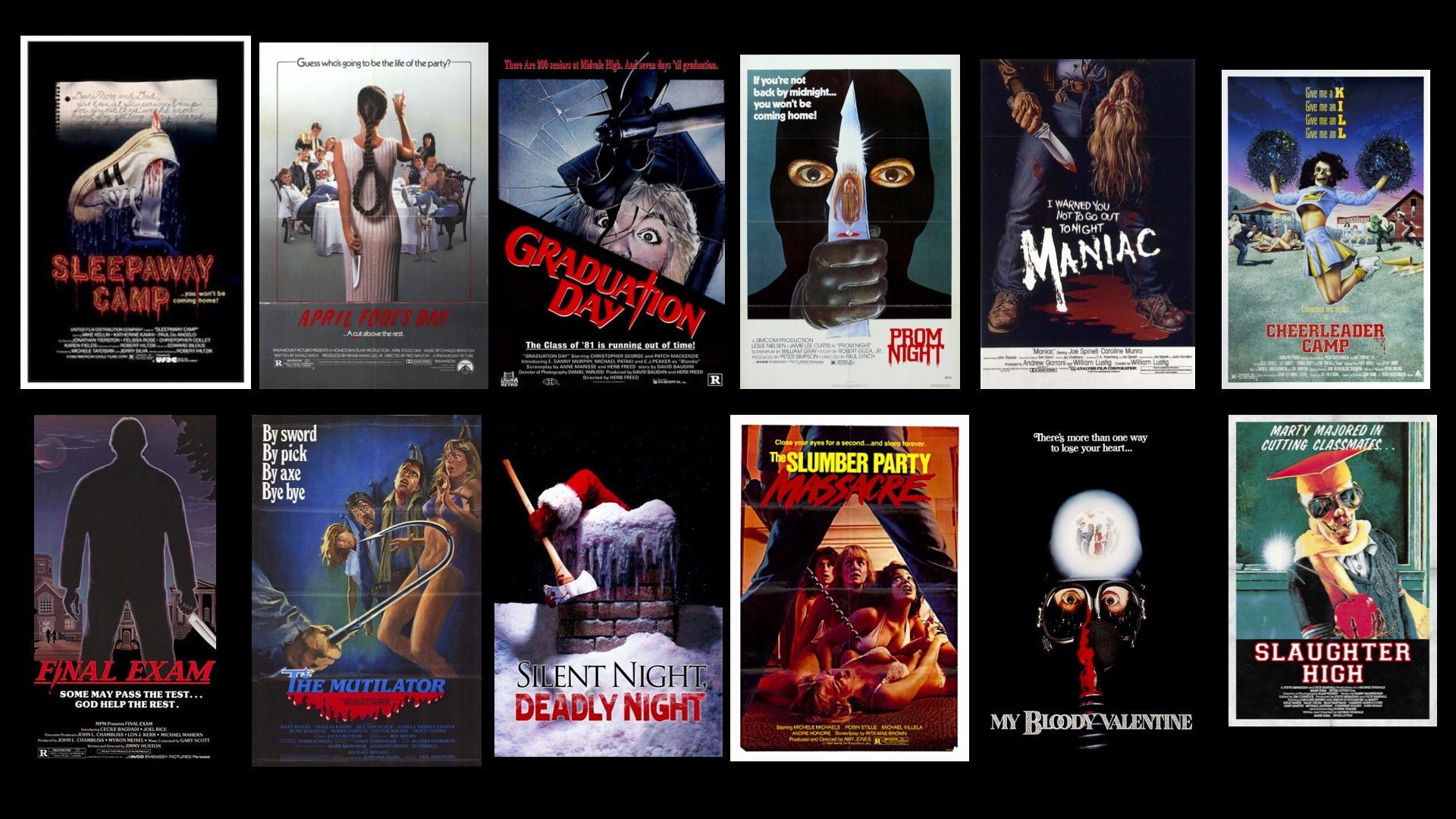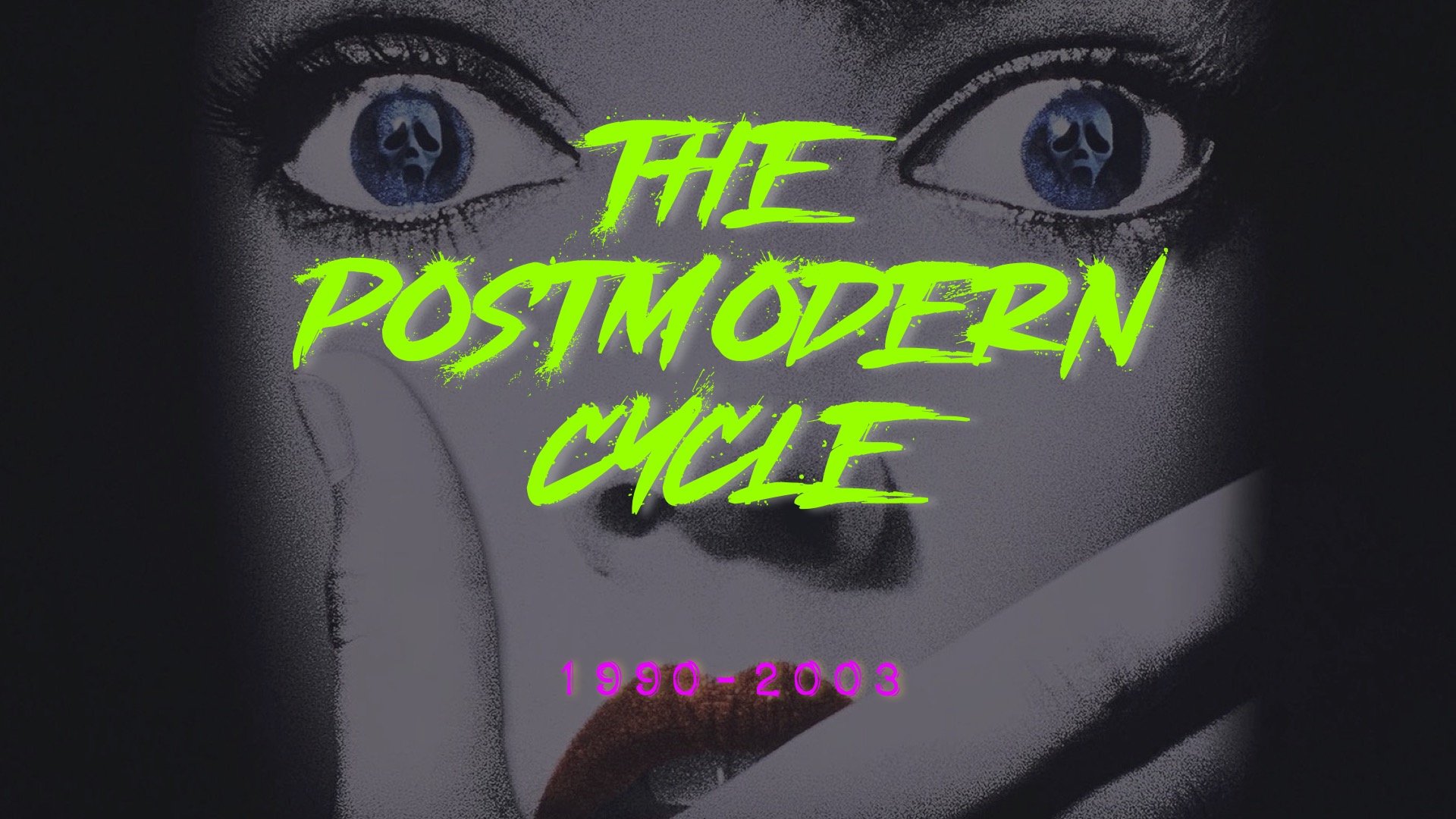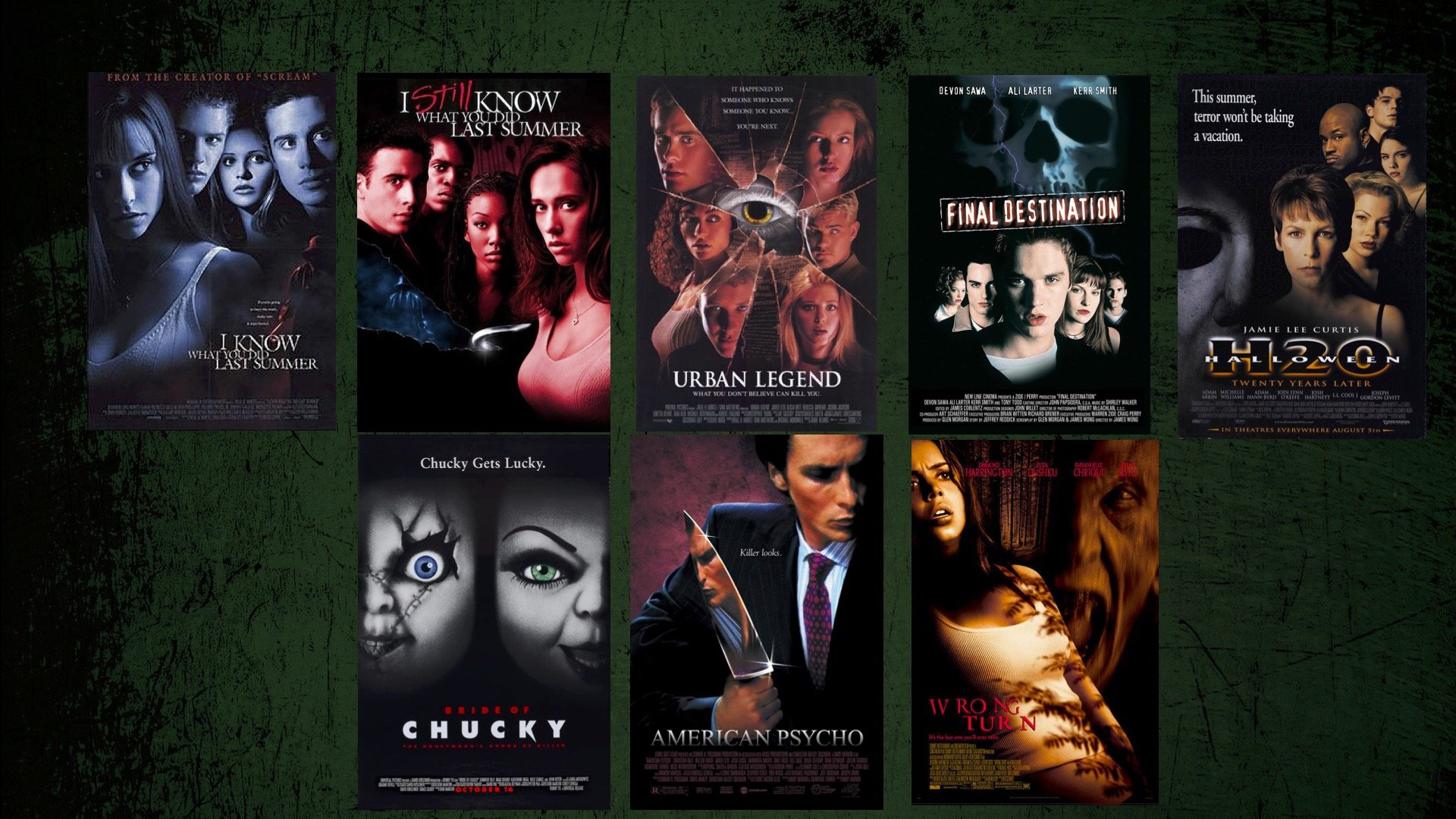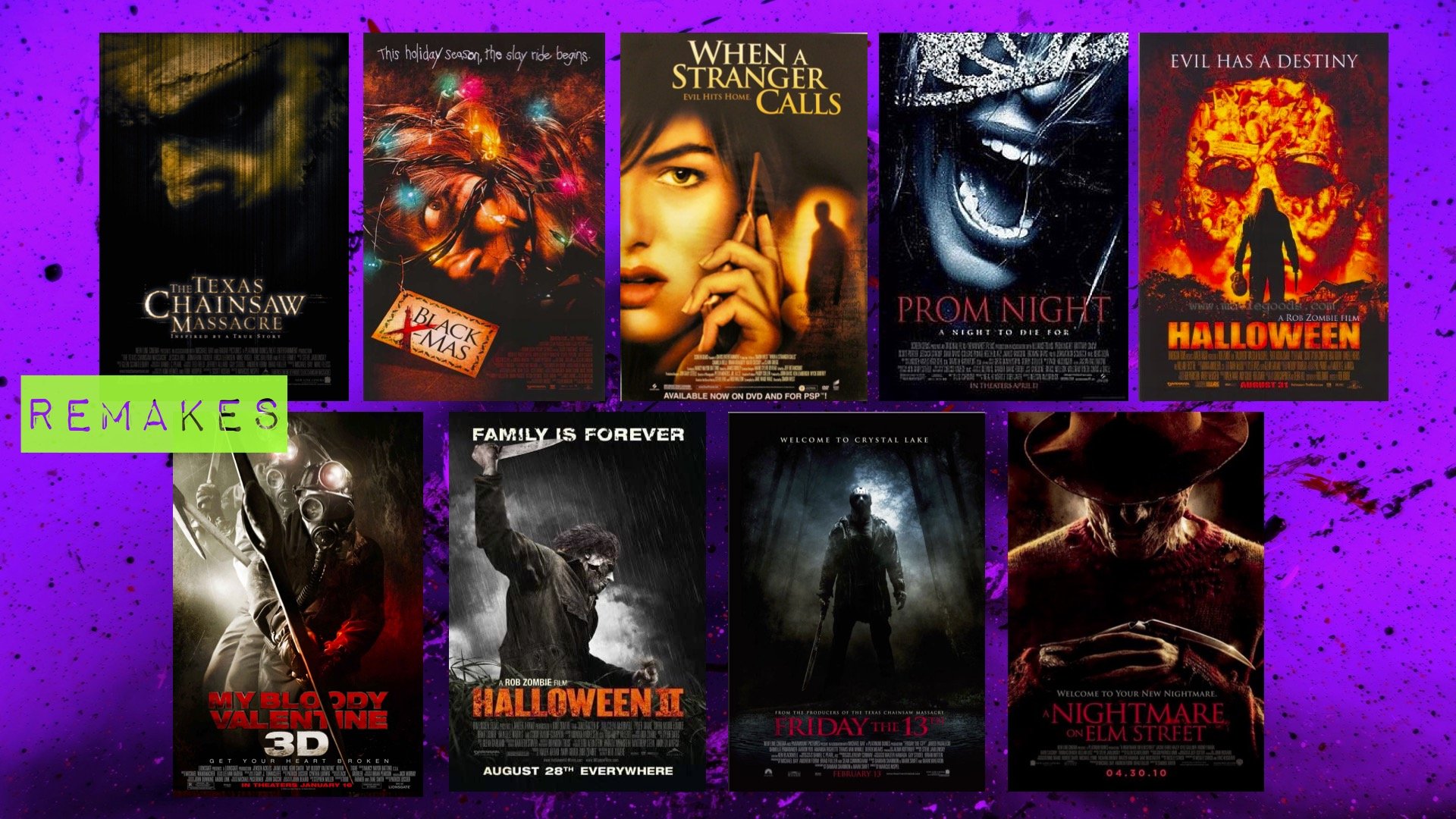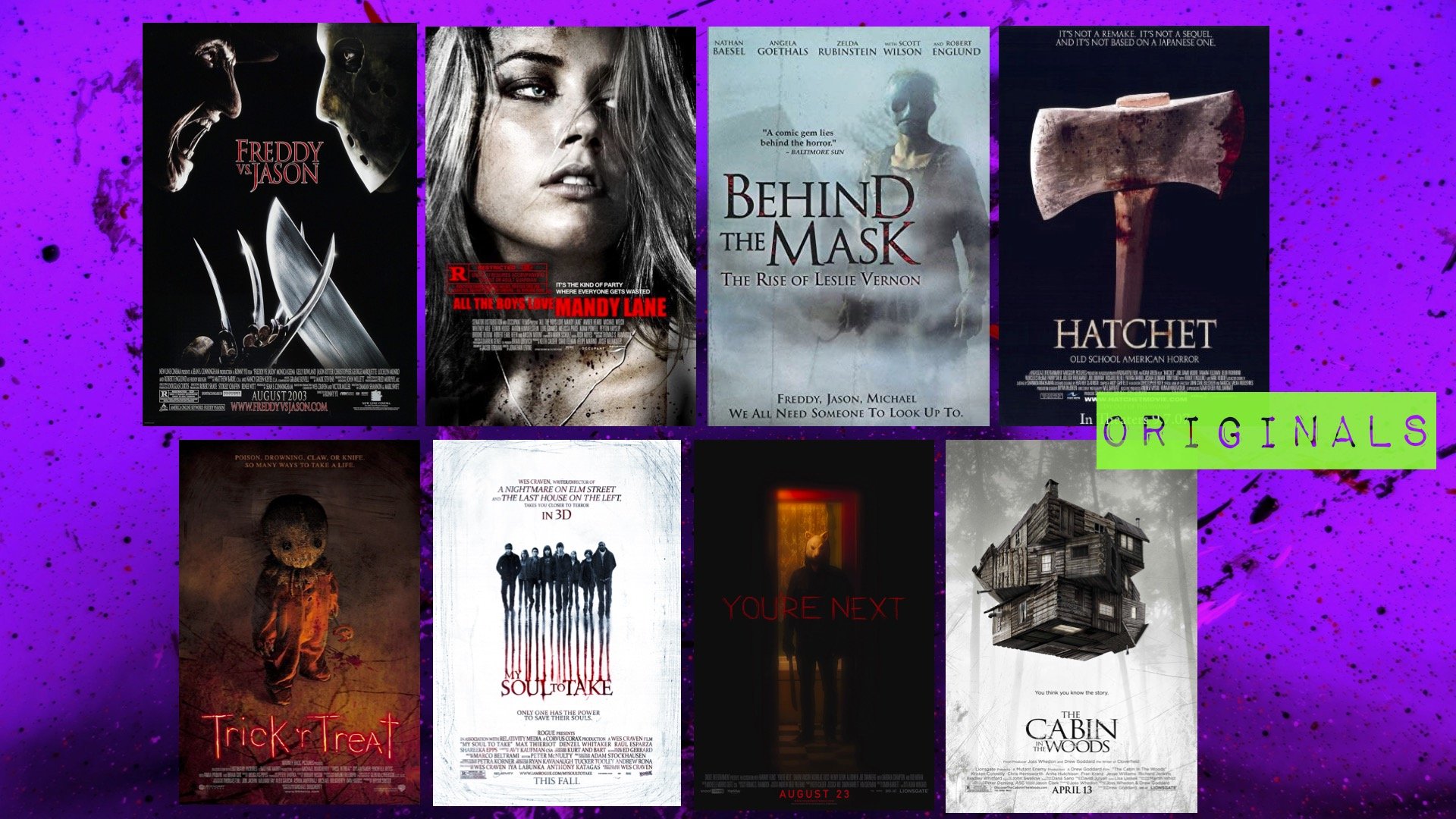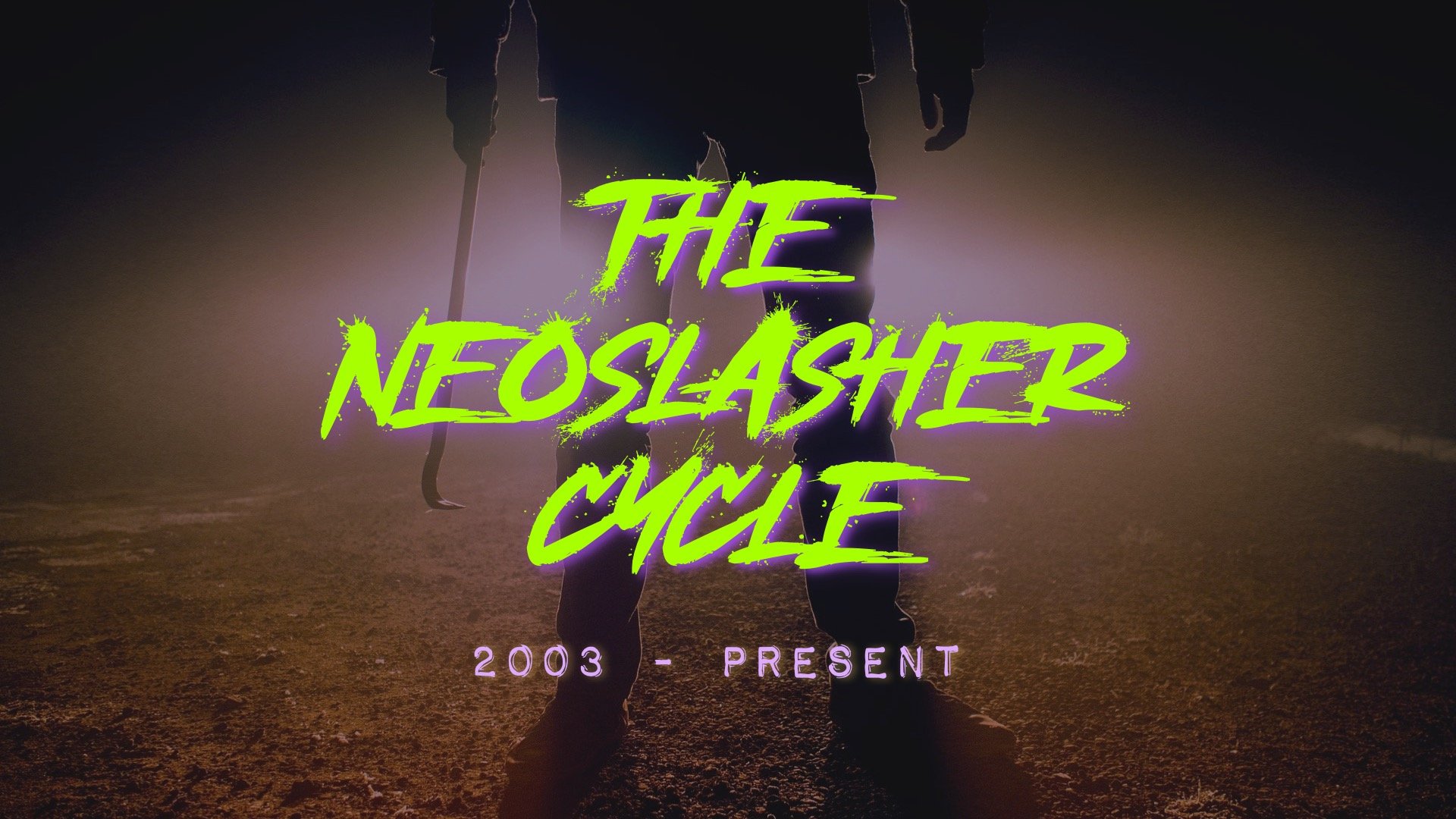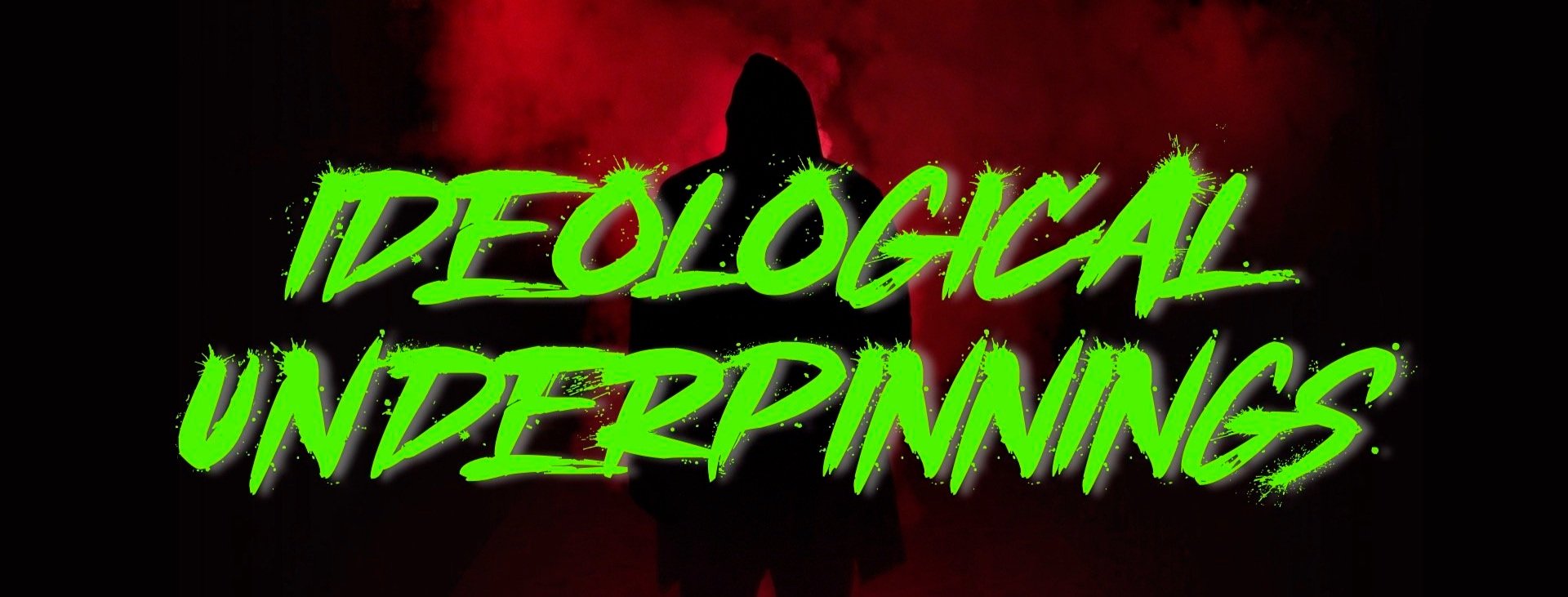“They always started with a kill scene”: Reboots, Requels, and The Slasher Cycle
NOTE: This is a slightly edited version of a paper delivered at the 2023 Southwest Popular and American Culture Association conference in Albuquerque, NM.
One of the most popular and enduring subgenres of horror film, the slasher initially hacked its way onto the big screen and into the cultural imaginary in the 1970s. Like other monsters in the horror canon, the slasher villain—wielding a variety of weapons, from knives, machetes, and axes to sickles, chainsaws, and the occasional wood chipper or bread slicer—has long functioned as a manifestation of the “monster as metaphor,” a means through which horror engages in critique of cultural ideologies. The surfeit of contemporary slashers, both new and remakes/ reboots, indicates we have indeed reached another high tide moment for the slasher film—in addition to recent one-off films like Happy Death Day (2017) and Happy Death Day 2U (2019), Bodies Bodies Bodies (2022), Freaky (2020), Christmas Bloody Christmas (2022), X (2022), There’s Someone Inside Your House (2021), and Piggy (2022), there are also the remakes/ reimaginings and adaptations such as Wrong Turn (2021), Texas Chainsaw Massacre (2022), Candyman (2022), and the Fear Street Trilogy (2021)—as well as what the character of Mindy in 2022’s Scream terms the “requel” of that film series as well as that of the Halloween franchise. What I want to consider in this paper is the idea that throughout the slasher cycles of the 70s and 80s, the mid- to late 90s and early 2000s, the Post-9/11 era, and continuing into our current neoslasher era, the slasher villain is and always has been directly shaped by the concomitant influences of our repressed cultural fears and the rise of sociopolitical conservativism.
Throughout its history, the slasher film has featured a kind of moralizing tension between conservative and progressive cultural standards; early instantiations of the Final Girl, after all, were marked by her comparatively conservative social values. In order to consider our contemporary slasher cycle’s political and ideological underpinnings, I’ll briefly trace the origins of the slasher film in the 1970s and 80s and consider the turn toward postmodern self-awareness in the 1990s as well as the nihilistic post-9/11 cycle in order to contextualize this current neo-slasher period. In doing so, I will consider the slasher in terms of the cyclical nature of horror and look at the social anxieties with which these distinct periods contend as a way to consider what our current slasher cycle signifies in a broader cultural sense.
The slasher film is one of the most recognizable subgenres of horror—and one of its most popular. In order to effectively situate this subgenre, I think it is helpful to first consider the question that perennially haunts horror studies:
IS HORROR IDEOLOGICALLY PROGRESSIVE OR CONSERVATIVE?
Scholars and fans have debated about this almost since the inception of the genre in literature, and certainly since the appearance of the horror film—see the critical work of Stephen King, Noel Carroll, Linda Williams, Philip Brophy, Carol J. Clover, et al.. My view is that horror is almost categorically never EITHER/ OR in any regard. Some horror is progressive. Consider the politics of films like Night of the Living Dead (1968) and its sequels, or John Carpenter’s They Live (1988), or David Cronenberg’s Videodrome (1983). We see an emphasis on progressive politics as the takeaway—although often through satirical means—in films like The Purge (2013), Get Out (2017), Jennifer’s Body (2009), Green Room (2015), Ginger Snaps (2000), American Mary (2012)—and many more.
However, the slasher film, I would argue, tends toward conservatism, which is why the slasher cycles back around in moments of social moral panics and rhetorical lip-service to the idea of “family values.” After all, the classic slasher villain typically targets victims who violate social dictates and norms. Partying, camping or visiting a cabin in the woods, for instance, is a slippery slope, and often leads to drug and alcohol consumption, premarital sex, and / or summoning demons, either by accident or intention. The figure of the slasher is there to mete out punishment for such transgressions. As horror scholar Robin Wood argues, horror film is bound up in the “return of the repressed”; he writes, “What escapes repression has to be dealt with by oppression.” The slasher villain is a tool of that oppression—he (usually he) oppresses all those surplus eruptions of behavior that conservative politics believes “should” be repressed—usually with a sharp, stabby edge. Women, trans folks, queerness, any gender nonconforming behavior, non-whiteness, non monogamy, non-reproductive behavior—basically anything that acts as a threat to the white, cis, heterosexual, capitalist patriarchy is a prime target for elimination. When non-normativity fails to or refuses to be repressed—when it erupts—it must be oppressed; it must be slashed.
The slasher film, then, historically gets bound up in upholding dominant, conservative social mores by eliminating these eruptions of transgression. This isn’t an inviolable rule—films like Brian Bertino’s The Strangers (2008) or Ti West’s X (2022) or Christopher Landon’s Freaky (2020)—or even some of the later installments of classic slasher franchises, like Nightmare on Elm Street—are not so concerned with punishing wrongdoing as much as just punishing everyone for being home, being attractive, being young, or being alive. By and large though, an important constitutive element of slashers is that under all the increasingly elaborate kills, there is a sophisticated political ideology at work—one that works in tandem with cultural fears about difference and deviation.
As I mentioned, looking at the sociopolitical contexts of previous slasher cycles is useful in considering the current slasher milieu. Slashers as a genric movement really kicked off in the 1970s. John Carpenter’s 1978 Halloween is often credited as the first slasher film, but films like Tobe Hooper’s 1974 Texas Chainsaw Massacre and Bob Clark’s 1974 Black Christmas predated it. Nevertheless, while Halloween isn’t truly the first slasher, it is the most remembered, most successful, and certainly the most critically acclaimed. For baldly economic reasons, it also spurred production of other slashers, trying to capitalize on audience enthusiasm for blade-wielding madmen, thus putting into motion what we now call the first slasher cycle.
THE CLASSIC / GOLDEN ERA,
1974 - 1989
Like the wider horror genre, and, indeed, most genres of film, slashers tend to appear in cycles—cropping up in clusters, fueled by and feeding on their collective success. The Classic or Golden era of slashers is usually considered as stretching from 1974 - 1989.
In Anatomy of the Slasher Film, Sotiris Petridis sums up the formula of this period tidily: “a killer terrorizes a young community in an isolated place and in the end, a person, usually female, survives” (76). The classic slasher villain tends to stick to one primary weapon, they love to punish promiscuity, and they tend to stalk in one main locale—their hometown, the summer camp in which they died, the dreams of teenagers, etc. There is a lot of crossover with the stalker film, and the rise of POV shots offer vicarious thrills and / or voyeuristic identification with the killers.
POV shots from Black Christmas and Halloween
Literal hundreds of slasher films appear in this period, of wildly varying quality, and it’s when so many of our stalwart slasher franchises find their beginning—Halloween, of course, as well as Friday the 13th, Nightmare on Elm Street, more Texas Chainsaw Massacre films, as well as latecomer Child’s Play, which began in 1988. We also get less remembered but still classic slashers like April Fool’s Day, Slumber Party Massacre, Prom Night, Sleepaway Camp, and more, many of which garnered sequels of their own..
POSTMODERN / SELF-REFERENTIAL CYCLE, 1991 - 2003
As a cyclical generic turn, the postmodern or self-referential slasher cycle comes about during the first Bush Administration, and reinvigorates a genre that had gotten stale—so many of the classic slasher plots and characters had been recycled and reused to the point of very diminishing returns.
The postmodern era, then, is both reacting to the largely conservative, paranoia-tinged political landscape as well as reacting to what were seen as cliché genre tropes, often using parody, irony, and satire to poke fun at the genre in which it was participating. An awareness of the predictability of the plots becomes part of the postmodern slasher, as do the typical “rules”—don’t have sex in the woods, don’t split up, don’t say you’ll be right back. The postmodern slasher mocks these, often to great effect. They also are influenced by the rise of Third Wave, Riot Grrrl feminism; Alexandra West argues that “their popularity stemmed from the fact that these films called into question the very rituals which were thought to make up a slasher and subverting them, but also because these films focused on the young women at the center of these films” (1).
Although 1996’s Scream is the most obvious example, the genre was already post-modernly remarking on itself before then. As early as 1991’s Freddy’s Dead: The Final Nightmare—sixth in the franchise—slashers are already exhibiting their awareness of how tired the formulaic classic slasher had become. 1994’s New Nightmare—written and directed by Wes Craven—is an incredibly postmodern approach to the NOES franchise and to the horror film industry—elements that are repeated in the Scream franchise.
This cycle overall is marked by the use of humor to undercut tension, melodramatic relationships between characters, and an explicit play with both the audience’s and the characters’ genre knowledge. Other self-referential films of this period include I Know What You did Last Summer (1997) and its sequel, Urban Legend (1998), Final Destination (2000), Halloween: H20 (1998), Bride of Chucky (1998), American Psycho (2000), and Wrong Turn (2003).
Mind you, some films after this designation are decidedly part of the postmodern slasher tradition—Shaun of the Dead was released in 2004, and 2010/12’s (depending on how you date it) Cabin in the Woods, one of my personal comfort films, is certainly one of these. This cycle was winding down at the start of the 21st century, but film never exists in a vacuum—and the events of September 11, 2001 radically shifted the American political landscape almost overnight.
POST 9/11 CYCLE, 2001 - 2011
As Kevin J. Wetmore Jr. notes in Post-9/11 Horror in American Cinema, the period following the 2001 attack on the World Trade Center was marked by significant difference from what came before, particularly in the horror genre.
He argues, “One key difference between pre-9/11 and post-9/11 horror is that the former frequently allows for hope and the latter just as frequently does not.” In terms of US horror, the September 11th attacks shaped media production in significant ways as the move toward a knee-jerk, reactionary conservativeness marked by fervent patriotism and nationalism was on the rise, which ushered in a resultant era of nostalgic aesthetics and remakes; in uncertain, scary times, we seek the comfort of the familiar—even from our scary movies, it seems.
In the wake of 9/11, one of the significant anxieties undergirding horror generally centered on the fear of dying a meaningless death. They are bound up in cultural anxieties about external dangers, xenophobia, nihilism, and meaninglessness. Two years after 9/11, remakes of classic slashers began to dominate cinematic horror; the first was 2003's The Texas Chainsaw Massacre, followed by Black Christmas (2006), When a Stranger Calls (2006), Halloween (2007), Prom Night (2008), My Bloody Valentine (2009), Halloween II (2009), Friday the 13th (2009), and A Nightmare on Elm Street (2010).
Original films of the era still often had some throwback element to them, reaching back into classic slasher history for inspiration, a trend in evidence in films like Freddy vs. Jason (2003), All the Boys Love Mandy Lane (2006), Behind the Mask: The Rise of Leslie Vernon (2006), Hatchet (2006), Trick R Treat (2007), My Soul to Take (2010), You’re Next (2011), and The Cabin in the Woods (2010/12).
THE NEOSLASHER CYCLE,
2003 - PRESENT
Although some slashers still appeared post 2012, the genre generally took a break as a supernatural horror cycle dominated for several years. Around 2016-2017, however—undergirded by the rise of Trump and red-hat MAGA fervor—we returned to another slasher cycle, one which is most often termed the neoslasher era.
The current crop of neoslashers—whether remakes, adaptations, or originals—also share many Post-9/11 central concerns about not mattering and about being victimized for no real reason, but they also convey the fear of being trapped by the material conditions of our lives. We see this in releases even in the last several years, from Ready or Not (2019), Happy Death Day (2017) and its 2019 sequel, and There’s Someone Inside Your House (2021) to The Final Girls (2015), The Purge franchise (2013-2022), and the Fear Street (2021) trilogy.
We’ve also seen the rise of the “cyber slasher,” which contends with the horrors of surveillance capitalism, cyber stalking, and the dark side of social media; films such as The Den (2013), Unfriended (2014), Searching (2018), We’re All Going to the World’s Fair (2021), Missing (2022), and even aspects of the new fifth installment of Scream contend with these issues.
Scream 5 even directly addresses the cultural legacy of 90s slashers while playing with its tropic participation; when Ghostface calls Tara (Jenna Ortega) at the beginning of the film, echoing the Drew Barrymore opening from the first Scream, he asks if she remembers Stab, the horror film produced within the diegesis of the Scream franchise based on the events that happened in Woodsboro in the first Scream. “It started with a kill scene, right? They always started with a kill scene,” she answers, demonstrating a metamodern turn toward concomitant ironic parody and sincere enthusiasm.
“It started with a kill scene, right? They always started with a kill scene.”
Jenna Ortega as Tara in Scream 5
All that being said… why does the slasher seem to cyclically appear, and why are we in a resurgence of the subgenre now? In part, no doubt, it’s because horror—like film more generally, and like styles and trends culturally—moves in cycles. Every so often, we revisit found footage, or psychological thrillers, or possession stories, or invasion films. But those things don’t happen in a vacuum. Slashers in particular, I argue, tend to crop up in moments of rising political and social conservativism.
At the genesis of the genre, in the 1970s, America was contending with the lingering conflict in Vietnam, with Nixon’s Watergate Scandal, and then into the 1980s, with Reaganomics and the Family First and Moral Majority movements that centered Christian values as the “correct” American mode of comportment. The postmodern slashers began to appear as the US shifted toward the reign of the Bush Administrations—even though Clinton was bookended by them, his scandal-tinged terms and impeachment proceedings for sexual misconduct resulted in a snapback effect that fed the rise of conservative rhetoric. National tragedies such as the Oklahoma City Bombing and the Columbine High School shootings heightened tensions throughout the late 1990s, and the uncertainty concerning the Y2K bug gave rise to cultural paranoia. The Post 9/11 era took hold in the wake of national tragedy under Bush Jr. and the deep anxiety and xenophobia that followed. And now, you may have noticed, we are very much back in a slide toward conservative politics, toward the inescapability of the internet and our social surveillance culture, toward the criminalization of and violence toward queer communities, and toward deep economic precarity. The slashers coming out now reflect these anxieties. They center concerns about the rise of fascism, the terror of mob rule, the dissolution of personal agency, the struggles of poverty. This cycle of slashers is admittedly somewhat different to its predecessors, because the world itself is different; these days, characters of color and non-heteronormative characters may actually survive the slasher, and may even be figured as Final Folks. But the anxieties encoded in the films still reflect larger social issues and cultural discourses, coded though they may be.
At its heart, the slasher is a bloody, violent cautionary tale. The Final Girl archetype has changed throughout the years—once virginal, demure, inescapably straight, and morally righteous, the Final Folks that populate slashers now can have sexual agency, can be something other than middle class straight white cis girls—but the demand that the Final Folks be resourceful and tenacious still shapes the slasher narrative. The genre, too—especially in its more self aware moments—is not unaware of how the slasher format has tended to reify these conservative values, which is why conservative ideology gets confronted head on in many contemporary slasher films. Ultimately, the slasher is a natural vehicle for confronting this moment in our political hellscape—for that reason, if no other, don’t expect them to go away any time soon.
REFERENCES
Sotiris Petridas, Anatomy of the Slasher Film: A Theoretical Analysis
Alexandra West, “‘Not in my movie’: The 90s Slasher Cycle and Grrl Power”
Kevin J. Wetmore, Post 9/11 Horror in American Cinema
Robin Wood, “Introduction to the American Horror Film”


